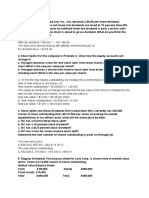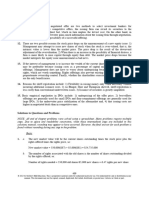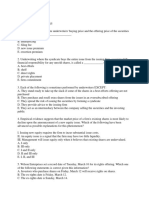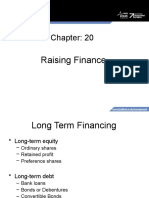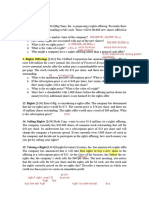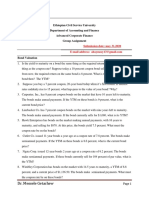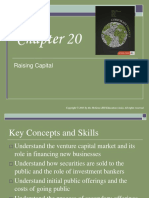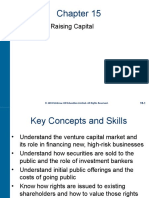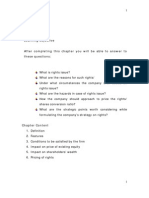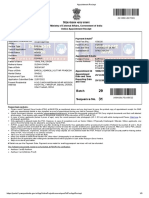Corporate Finance
Questions and Practice problems_Chapter 20
Chapter 20:
Concept questions (page 650 textbook): 4, 8, 10, 11, 12, 13, 15
Questions and Problems (page 652 textbook): 1, 2, 3, 8
Solution
Concept questions:
4. Yields on comparable bonds can usually be readily observed, so pricing a bond issue
accurately is much less difficult.
8. The evidence suggests that a non-underwritten rights offering might be substantially cheaper
than a cash offer. However, such offerings are rare, and there may be hidden costs or other
factors not yet identified or well understood by researchers.
10. a. The price will probably go up because IPOs are generally underpriced. This is especially
true for smaller issues such as this one.
b. It is probably safe to assume that they are having trouble moving the issue, and it is
likely that the issue is not substantially underpriced.
11. Competitive offer and negotiated offer are two methods to select investment bankers for
underwriting. Under the competitive offers, the issuing firm can award its securities to the
underwriter with the highest bid, which in turn implies the lowest cost. On the other hand, in
negotiated deals, the underwriter gains much information about the issuing firm through
negotiation, which helps increase the possibility of a successful offering.
12. There are two possible reasons for stock price drops on the announcement of a new equity
issue: 1) Management may attempt to issue new shares of stock when the stock is over-valued,
that is, the intrinsic value is lower than the market price. The price drop is the result of the
downward adjustment of the overvaluation.
2) When there is an increase in the possibility of financial distress, a firm is more likely
to raise capital through equity than debt. The market price drops because the market interprets
the equity issue announcement as bad news.
13. If the interest of management is to increase the wealth of the current shareholders, a rights
offering may be preferable because issuing costs as a percentage of capital raised are lower for
rights offerings. Management does not have to worry about underpricing because shareholders
get the rights, which are worth something. Rights offerings also prevent existing shareholders
from losing proportionate ownership control. Finally, whether the shareholders exercise or sell
their rights, they are the only beneficiaries.
15. Basic empirical regularities in IPOs include: 1) underpricing of the offer price, 2) best-efforts
�offerings are generally used for small IPOs and firm-commitment offerings are generally used
for large IPOs, 3) the underwriter price stabilization of the aftermarket and, 4) issuing costs are
higher in negotiated deals than in competitive ones.
Questions and Problems:
Question 1: Again, Inc., is proposing a rights offering. Presently, there are 550,000 shares
outstanding at $87 each. There will be 85,000 new shares offered at $81 each.
a. What is the new market value of the company?
b. How many rights are associated with one of the new shares?
c. What is the ex-rights price?
d. What is the value of a right?
e. Why might a company have a rights offering rather than a general cash offer?
a) a. The new market value will be the current shares outstanding times the stock price plus
therights offered times the rights price, so:
New market value = 550,000*($87) + 85,000*($81) = $54,735,000
b) The number of rights associated with the old shares is the number of shares outstanding
dividedby the rights offered, so:
Number of rights needed = 550,000 old shares/85,000 new shares = 6.47 rights per new
sharec.
c) The new price of the stock will be the new market value of the company divided by the
totalnumber of shares outstanding after the rights offer, which will be:
PX = $54,735,000/(550,000 + 85,000) = $86.20
d) The value of the right Value of a right = $87.00 – 86.20 = $0.80
e) - Protect against underpricing
- Less cost
- Make sure for raising capital
Question 2: The Clifford Corporation has announced a rights offer to raise $28 million for
a new journal, the Journal of Financial Excess. This journal will review potential articles
after the author pays a nonrefundable reviewing fee of $5,000 per page. The stock
currently sells for $27 per share, and there are 2.9 million shares outstanding.
a. What is the maximum possible subscription price? What is the minimum?
b. If the subscription price is set at $25 per share, how many shares must be sold?
How many rights will it take to buy one share?
c. What is the ex-rights price? What is the value of a right?
d. Show how a shareholder with 1,000 shares before the offering and no desire (or
money) to buy additional shares is not harmed by the rights offer.
� a) The maximum subscription price is the current stock price, or $27.
The minimum price is anything greater than $0 = 0 < subscription price < $27
b) The number of new shares will be the amount raised divided by the subscription
price, so:
Number of new shares = $28,000,000/$25 = 1,120,000 shares
And the number of rights needed to buy one share will be the current shares outstanding divided
by the number of new shares offered, so:
Number of rights needed = 2,900,000 shares outstanding/1,120,000 new shares = 2.59
c) Px = (27*2,900,000 + 28,000,000)/(2,900,000+1,120,000) = 26.44
So, the value of a right = $27 –26.44 = $.56
d) Before the offer, a shareholder will have the shares owned at the current market
price, or:
Portfolio value = (1,000 shares)*($27) = $27,000
After the rights offer, the share price will fall, but the shareholder will also hold 1,000
rights, so:
Portfolio value = (1,000 shares x $26.44) + (1,000 rights x $0.56) = $27,000
3. Number of new shares issued = $15,000,000 / $50 = 300,000 shares
Let C be the number of current shares outstanding before the rights offering, we have the
equation of the ex-rights price:
PX = (Cx$65 + $15,000,000) / (C + 300,000) = $63.18
Solve for C = 2,172,527 shares
8. PX = (PRO x nold + PS x nnew) / (nold + nnew)
PRO x nold =135,000*75=$10,125,000
Case1: the new share price is $75
Px=(10,125,000+30,000*75)/(135,000+30,000)=$75
-> Remain the same
Case2: the new share price is $70
Px=(10,125,000+30,000*70)/(135,000+30,000)=$74.09
-> drop by $0.91 per share
Case3: the new share price is $65
Px=(10,125,000+30,000*65)/(135,000+30,000)=$73.18
-> drop by $1.82 per share




